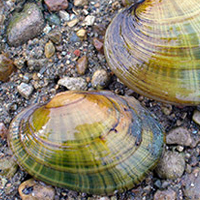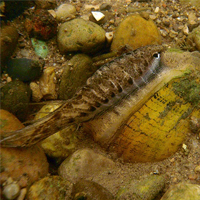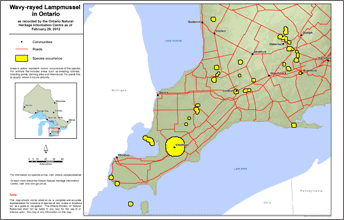Wavy-rayed lampmussel
Scientific name: Lampsilis fasciola


Cover photos credit: Chris Wilson (all photos)
Status
Threatened
“Threatened” means the species lives in the wild in Ontario, is not endangered, but is likely to become endangered if steps are not taken to address factors threatening it.
Date added to the Species at Risk in Ontario List
The Wavy-rayed lampmussel was already assessed as threatened when the Endangered Species Act took effect in 2008.
Read the assessment report (June 2010).
What it looks like
The Wavy-rayed lampmussel is a medium-sized freshwater mussel. It can reach ten centimetres in length and can live up to 20 years. This species is characterized by its yellow or yellowish-green, rounded shell that has numerous thin wavy green lines.
Where it lives
The Wavy-rayed lampmussel is usually found in small to medium rivers with clear water. It lives in shallow riffle areas with clean gravel or sand bottoms. Like all mussels, this species filters water to find food, such as bacteria and algae. Mussel larvae are parasitic and must attach to a fish host, where they consume nutrients from the fish body until they transform into juvenile mussels and drop off. The Wavy-rayed lampmussel’s fish hosts are the Largemouth bass and Smallmouth bass. The presence of fish hosts is one of the key features for an area to support a healthy mussel population.
Where it’s been found in Ontario
In Canada, the Wavy-rayed lampmussel is found only in Ontario in the Grand, upper Thames, Maitland, Ausable and St. Clair rivers, and the Lake St. Clair delta. It has disappeared from Lake Erie, the Detroit River and most of Lake St. Clair, and may also be gone from the Sydenham River.
View a larger version of this map (PDF)
What threatens it
The main threats to the Wavy-rayed lampmussel are pollution and siltation, which occurs when too much soil washes into the river from nearby agricultural and urban areas. The Zebra mussel, an invasive species from Europe, has caused the loss of populations in the Great Lakes and connecting channels and could threaten river populations if they invade reservoirs on these systems. Conditions that threaten the fish host species also threaten the Wavy-rayed lampmussel. Predation by muskrats may also be a problem for small populations.
Action we are taking
Threatened species and their general habitat are automatically protected.
Recovery strategy
A recovery strategy advises the ministry on ways to ensure healthy numbers of the species return to Ontario.
Read the executive summary and full document (February 18, 2011).
Government response statement
A government response statement outlines the actions the government intends to take or support to help recover the species.
Read the government response statement (November 18, 2011).
Five-Year Review of Progress
A five-year review reports on progress made toward protecting and recovering a species, within five years of publishing a species’ government response statement.
Read the report on progress towards the protection and recovery of 27 species at risk, including Wavy-rayed Lampmussel (2016).
Habitat Protection
A habitat regulation defines a species’ habitat and may describe features (e.g. a creek, cliff, or beach), geographic boundaries or other unique characteristics.
Read the habitat summary (January 1, 2015)
Read the regulation (January 1, 2015)
What you can do
Report a Sighting
Report a sighting of an endangered animal or plant to the Natural Heritage Information Centre. Photographs with specific locations or mapping coordinates are always helpful.
Volunteer
Volunteer with your local nature club or provincial park to participate in surveys or stewardship work focused on species at risk.
Be a good steward
- private land owners have a very important role to play in species recovery; if you find wavy-rayed lampmussels on your land, you may be eligible for stewardship programs that support the protection and recovery of species at risk and their habitats
- you can help improve mussel habitat and keep Ontario’s water safe and clean by maintaining natural vegetation next to creeks and rivers; the roots of plants reduce erosion and can stop soil from washing into the river; fence off streamside areas to keep cattle (and their manure) out of the water; there are many other things that you can do to help reduce soil erosion and you might be eligible for funding assistance; for more information, visit the Ontario Soil and Crop Improvement Association
Report illegal activity
Report any illegal activity related to plants and wildlife to
Quick facts
- the Wavy-rayed lampmussel can fish; to attract a fish host that its parasitic larvae can attach to, the female produces a lure that looks like a wriggling minnow; when a fooled fish attacks the lure, the mussel ejects its larvae, which have a better chance of attaching to the host at such a close distance
- the Wavy-rayed lampmussel is known to produce four different fishing lures; the lure can be bright red, black, or even resemble a minnow, complete with eye spots
- mussels are good indicators of environmental health; since they have a complex life cycle, are long-lived (some species can live up to 100 years) and eat by filtering water and its pollutants, mussels can provide a snapshot of how healthy our waterways are
- Aboriginal people harvested mussels for food and to create jewelry and tools; in the 1800s, massive numbers of mussels were harvested from the Grand River to create buttons; millions were shipped out every year until the 1940s when plastic became more popular
